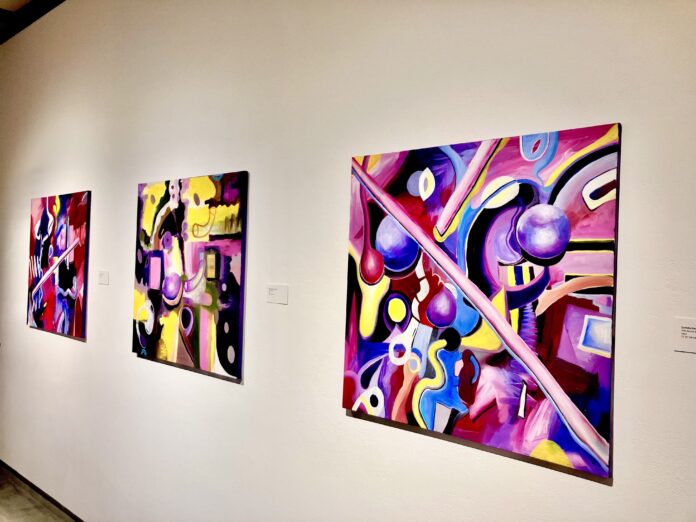
Abstract shapes and colors jump out from the canvas that hangs on the stark white wall as you enter through the doors of the Donna Beam Gallery. As you turn the corner, two yellow figures stand around a lightbulb, representing father and son in conversation with each other. Attendees of the exhibit sit at the benches, their eyes fixed and enamored with the pieces displayed. The gallery recently opened the “Diversified III” exhibition on Sept. 5, making it the third installment in the series celebrating UNLV Department of Fine Arts’ part-time instructors, allowing them a platform to showcase their art.
Diversity plays a central role in the exhibition, with UNLV Director of Galleries Jerry Schefcik explaining, “The title is a descriptor of the artists and the work. We have a diverse faculty. Their gender, their ethnicity, almost everything that you can apply to an individual. They have diverse ideas.” This diversity of ideas is shown in the various methods and art mediums that are on display. “Sussex Sights,” a video piece by Rebekah Venturini, is different from Rebekah Andrade’s oil and acrylic canvas painting titled “Beach Themed.” And this is intentional. “There’s some paintings, there’s photography, installations, video,” says Director Schefcik, “There’s a variety of media. That’s the other side of ‘Diversified.’”
In his role, Director Schefcik curates the art pieces that are put on exhibition with extensive thought and care. “I try to put things where they will be looked at and appreciated,” Director Schefcik says, “and not be in competition for attention with the other work around it.” For “Diversified III,” Director Schefcik also chose to keep the artist’s work together, “It helps the artist make a statement on what they want to communicate.”
Mixed media artist Jung Min painted a set of three untitled works for the exhibition. “Untitled 1” sits in the center of the series of three works, all made with ink on paper. “Untitled 1” depicts a female figure with flowing hair, and dots and splotches cover and blur her face. Aleyghzja Patino, an attendee at the exhibit, chose this piece as her favorite. Patino says, “As a psychology major, I think it’s tied to bipolar disorder. I see what’s inside of people and how they perceive themselves. The way her face is blurred out represents, to me, depersonalization. Sometimes we look at ourselves in the mirror and we don’t feel like ourselves.”
Representational painter Andrea Pavles contributed the painting “Gods and Monsters” to the exhibit, a piece inspired by her children’s superhero action figures and dinosaur figurines. The vibrant and lively painting is the first painting displayed when you enter through the front doors of the exhibit. “I was also working on it when a new Godzilla movie hit theaters, and I think there was a ‘Justice League’ movie dropping on HBO, so gods and monsters were in the air,” Pavles explained. “I’m primarily a figurative painter, and I’m interested in making paintings that blend domestic, fantasy and mythological narratives… I enjoy playing around with moments where life imitates art. I also enjoy celebrating play itself, and toys are a perfect symbol for that.”
Marjorie Barrick Museum of Art’s senior graphic designer Chloe Bernardo created two pieces for the exhibition – “Sulyap” and “Tabi Tabi Po: Manananggal at Dwende” – giving the public a glimpse into her Filipino heritage. “I think both pieces came from a place of longing,” Bernardo says. “I moved from the Philippines to the U.S. as a teenager, and I realize now that it’s a place that I’m always going to miss.” Bernardo’s pieces capture a sense of nostalgia and connection to her past. “Sulyap” is an homage to the street vendors and snacks from her childhood. In the piece, light illuminates the ink printed on a capiz window, depicting the importance of food to Filipino families.
“Tabi Tabi Po: Manananggal at Dwende” is Bernardo’s attempt at grounding Filipino oral folklore into a physical medium that will stand the test of time. The piece utilizes lighting behind a decorated curtain to demonstrate her heritage. “I think about my nieces and nephews growing up here in the U.S. and how they might not have a chance to hear these stories,” Bernardo said. “They will not be passed on.”
Students can see the pieces and visit the exhibit at the Alta Ham Fine Arts building in the Donna Beam Fine Arts Gallery on weekdays from 9 a.m. to 5 p.m.. Admission is free and open to the public.
